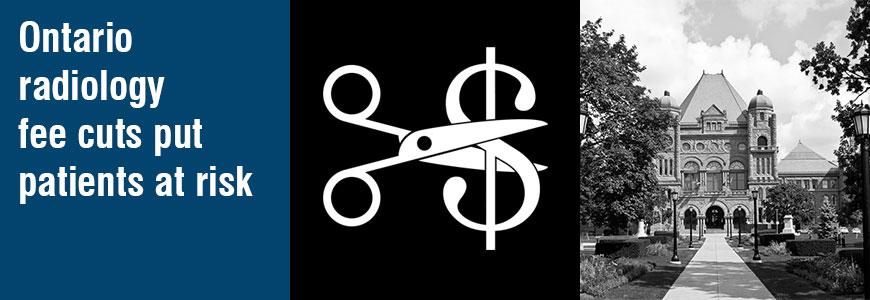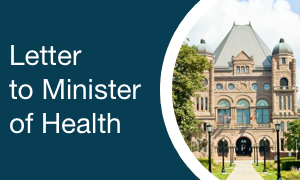
Government Imposes Additional Fee Cuts
The Ontario Association of Radiologists (OAR), on behalf of the province’s 1,000 radiologists are gravely concerned and disappointed in the province’s recent unilateral move to cut an additional $235 million dollars from an already stressed health care system. According to an OMA analysis, radiology is facing a $60M fee reduction or 25% of the total reduction. The fact that Radiologists have been hit inordinately by this latest cut sends a confusing message as to what the government and the Ministry expect from the medical specialists doing the brunt of the medical imaging diagnoses for Ontario’s more than 13 million patients.
In January the Ministry of Health and Long-Term Care announced across-the-board cuts. Now in September, the government is targeting an inordinate share of the $235M cut on targeted groups of physicians like our specialty with no clarity as to what you are seeking to accomplish on a patient care level. This significant shift in direction is reckless and prone to seismic impacts on the delivery of diagnostic imaging services.
“In my 20 years of medical practice, I cannot recall a time when there was more confusion about what the government is expecting from doctors and the least opportunity to engage with the Minister and Ministry to collaborate to find solutions. All we hear are unilateral statements about more cuts and dramatically different ways to make them happen even though it is obvious to us in the field that these changes, made without any consultation, will have a harmful effect on patient care and safety, and undermine physicians’ ability to provide Ontarians with the highest standard of quality health care services.”
It’s not clear how the government is expecting us to modify our practices to meet these major cuts while still responding to growth in patient demand for medical services of all kinds. Where are the channels of communication for expert physician groups like the OAR to advise you? In less than 10 days time, the unilateral cuts will be in effect before physicians understand how it will impact their practices and can provide the government with an opportunity to rectify some of the unintended consequences to patient care delivery. We cannot believe that the government’s intent is to reduce the level of patient care in Ontario, but that is precisely what you risk with these cuts.
The following is a synopsis of some of the top line issues that should be of mutual concern:
Impact on Patient Care Services
- All diagnostic ultrasound and nuclear medicine fees will be reduced by 20%.
- MSK ultrasound fees have now been reduced by 63% and scrotal ultrasound by 74%, well over the 20% reduction for other ultrasound codes.
- The unintended impact on patients is that these services will largely either cease to exist as of October 1st, or be greatly reduced with long wait lists and undiagnosed patients because the service is no longer viable.
- That means that the more than 700,000 MSK ultrasounds performed annually (2011/12 - OHIP data) will be significantly impacted thereby directly affecting patients.
- Another estimated 100,000 scrotal ultrasounds may not be performed, or significantly delayed
- These exams may be referred to other diagnostic imaging modalities with significantly greater costs to the health care system, the possible use of ionizing radiation, and clogging other diagnostic imaging equipment resulting in longer wait lists.
- MOH officials apparently believe there is no value in having a Radiologist present to intervene and to supervise the patient examination even though that is an integral part of the quality management process. It is hard to imagine how you would convince Ontario patients that the quality of their care has been protected or improved.
- The government is specifically discouraging interaction and quality assurance in some of the most challenging situations, such as complex oncology cases and breast imaging.
- Radiologist interaction with referring physicians will be discouraged and having a local presence in smaller communities and hospitals will be much less attractive.
Impact on Funding the Cost of Delivering Diagnostic Imaging Services (Technical Fees)
- Technical fees are the overhead OHIP funding that covers the cost of the medical equipment, the specialized technical support staff, medical supplies and space for diagnostic services. Radiology accounts for about 70% of all technical fee expenditures in both public hospitals and IHFs.
- The January, and now the September, across-the-board fee cuts totaling 4.45% are directly affecting the amount of funding available to cover the overhead cost of delivering medical imaging services to patients in all practice settings.
- There have been no fee increases to DI technical funding in over 25 years.
- The results of the almost 5% technical fee cut will translate into decisions to not replace older DI equipment due to the lack funding and a laying off of highly trained diagnostic technologists as the impact of these cuts work their way into the delivery of patient care services.
- This means a decreased number of DI scanners with greater diagnostic capability will be purchased and a reduced availability of diagnostic technical staff who are let go or not hired.
- As physicians, we will see the impact directly as will referring physicians who will be waiting longer for basic diagnostic examination results. In most cases, the reductions in service will not be obvious to patients at first, but will become increasingly clear as waits increase, or services are reduced or terminated.
Undermining MOH’s Own Quality Care Agenda
- Successive physician fee cuts are at cross-purposes to important initiatives sponsored by MOH and the Ontario government and undermine the quality assurance and quality management agenda in health care
- Many of these initiatives related to DI and radiologists are at the forefront working with the MOH to ensure their adoption and implementation
- A large slate of DI quality assurance issues are at peril including, but not limited to, province-wide DI peer review, CPSO-CCO Quality Management Program initiatives including mammography, OBSP, CPSO IHF assessments, imaging accreditation programs (mammography, BMD), HARP Act modernization, etc.
Inconsistency In Dealing with Physician Funding Cuts
- At this point we have no idea of what the total impact on radiologists will be due to the lack of available information, but it is likely that Radiologists, who are less than 4% of the physician community, are going to bear up to 20% of the total $235M cut to physician funding. This needlessly exposes you to future criticism when unavoidable service impacts occur.
- More than a week has passed since the news of these cuts was announced yet there is an unprecedented paucity of information available to the OMA and to individual physicians or sections of medicine
- In January 2015, the Ontario government announced an across-the board cut affecting all doctors in Ontario yet the September 2015 announcement is a more punitive hybrid of a 4.45% across-the-board decrease combined with a major fee cut that singles out a small number of medical specialists and a blanket cut for those hard working physicians earning higher than average incomes.
- This means that radiologists and a few other specialties will face decreases of up to 10%.
- Some practices will be significantly impacted such that they will be forced to change the mix of diagnostic services they offer. Those kinds of changes will create unintended consequences that will affect patient care delivery.
- There is no equivalent 20% reduction to the emergency physician ultrasound code (H100).
- A call to the OMA as recently as yesterday, confirms that they are in the dark as to the implication and planned implementation of these new cuts.
Inequity of the Impact on Ontario Radiologists
- The impact of the 20% cut of ultrasound and nuclear medicine fees alone is estimated to be in the order of a fee reduction of $28M to Ontario radiologists.
- There are approximately 5,000 fee codes in the OHIP Schedule of Benefits. The new 20% fee cut affects approximately 190 fee codes of which 165 are procedures done by Radiologists and other imaging physicians. It is not clear why a small sub-set of the physician population is being treated so harshly with little apparent consideration to the deleterious impacts it will have on those physicians diagnosing cancer, stroke, heart disease and other leading causes of mortality and serious illness.
- There is a mixed and inaccurate message in this new fee cut. Clearly the government is concerned about the fiscal impact of the increased utiilisation of medical services yet you have stated publicly there is no reduction of access to medical services for the public and that further cuts to physicians can happen with no consequences to patient care.
- Radiologists do not refer patients to themselves. Within the medical profession, radiologists are bearing the cost of DI examinations ordered by other doctors. Radiologists are paying for the increase of these additional services without any fiscal responsibility being tied to the doctors who order them.
- Over the past decade, more non-physician health professionals (nurse practitioners, midwives, chiropractors, physiotherapists, etc.) have been authorized and encouraged by MOH to order diagnostic imaging exams. What started out as being a limited array of x-ray or ultrasound codes has now been expanded to more or all DI modalities and/or a much broader spectrum of fee codes that are charged to the physician pool. The volume of non-physician referrals is increasing. It is patently unfair that radiologists are now on the hook for the ordering practices and behaviour of non-physicians as well.
As an organization committed to the highest quality patient care for Ontarians and the advocates for Ontario radiologists, we respectfully request immediate clarification of the issues raised and for you to consult us directly so that appropriate action can be taken to reverse decisions that will lead to a serious erosion of patient care. I am available to meet you to discuss what we believe is a more proactive approach.
Sincerely,
Mark Prieditis, MD, FRCPC
President
